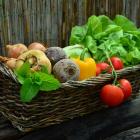You are here
» » What's the environmental impact of growing...
What's the environmental impact of growing your own food?
Buying locally grown food is a great way to minimize your environmental impact, and growing your own food takes that idea one step further. You might be surprised by the effect even a small vegetable garden can have on your carbon footprint. Here’s a simple calculation to show just how much energy you might be able save with your garden.
The first step is to calculate the typical energy cost associated with transporting food. It has been estimated that produce travels an average distance of 1500 miles before it is consumed [1]. Agricultural products are one of the top two commodities transported by semi-truck in the US, and a typical semi-truck gets about 5.6 miles per gallon of diesel while carrying 34,000 pounds of cargo [2,3]. Each gallon of diesel it burns releases 22.38 pounds of carbon dioxide into the atmosphere [4]. Based on these numbers, each pound of food releases 0.18 pounds of CO2 into the atmosphere from transportation alone! Stated another way, the energy associated with transporting a 5.2 ounce serving of broccoli is equivalent to 90.3 nutritional calories, even though it only provides 50 nutritional calories of energy when it is consumed [5].
Read more

